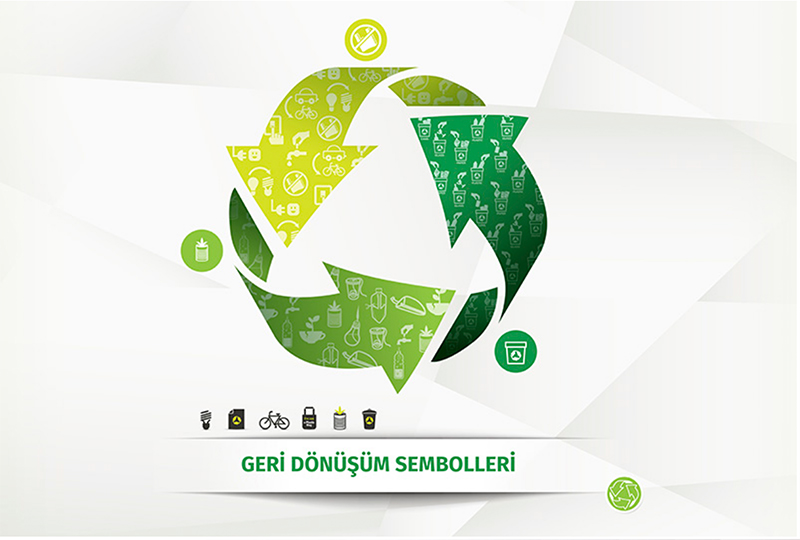We all know the importance of recycling very well now. But do we know exactly what we can recycle and how we can do it? As Netpak Ambalaj, we produce recycled products and protect the environment and nature. So, let's take a look at what the recycling symbols are and how products with these symbols can be recycled.
1.Mobius Cycle
Regardless of color, they all mean the same. This symbol indicates that the product can be recycled. However, it does not guarantee that the material will be accepted by the local recycling center or collection company. It also does not indicate that the product is made from recycled materials.

2.Green Dot
The meaning of the Green Dot is often confused with the Mobius Cycle. This point does not mean that the packaging is recycled or can be recycled. It indicates that the manufacturer has contributed financially to the recovery and recycling of the packaging.

3.Plastics
The purpose of the numbers inside the loops is to identify the type of plastic used for the product. Not all plastics are recyclable or reusable. There are many plastic-based products that cannot be broken down and recycled.
#1-PET (POLYETHYLENE TEREPHALATE)PET is one of the most widely used plastics in consumer products. It is available in most water and beverage bottles and some packaging. It is designed for single use applications. Repeated use increases the risk of growth of harmful organisms and bacteria. Products made from (PET) plastic should be recycled but not reused.
#2-HDPE (HIGH DENSITY POLYETHYLENE) HDPE plastic is a hard plastic used to make detergent and oil bottles, toys, and some plastic bags. HDPE is the most commonly recycled plastic and is considered one of the safest plastics. Recycling HDPE plastic for secondary use is a relatively simple and cost-effective process. HDPE plastic is very durable and will not degrade when exposed to sunlight, overheating or freezing. That's why HDPE is used for picnic tables, plastic lumber, garbage cans, park benches, bed covers for trucks, and other products that require weather resistance. Products made from HDPE can be reused and recycled.
3-PVC (POLYVINYL CHLORIDE)PVC is a soft, flexible plastic used to make blister packaging for clear plastic food packaging, teething rings, children and pet toys, and countless products. It is mostly used as a coating material for computer cables and to prevent plastic pipes and piping from splintering. Because PVC is relatively waterproof to sunlight and air, it is also used to make window frames, garden hoses, raised beds and trellis. PVC is called "toxic plastic" because it contains a large number of toxins that it can leach during its entire life cycle. Less than 1% of pure PVC material can be recycled. Products produced using PVC plastic cannot be recycled.
4-LDPE (LOW DENSITY POLYETHYLENE)LDPE is generally found in dry cleaning clothing packaging, plastics used in bread packaging. The plastic bags used in most stores today are also made using LDPE plastic. This type of plastic is also used in some clothing and furniture. LDPE is considered less toxic than other plastics and relatively safe for use. When recycled, LDPE plastic is used for plastic lumber, landscape boards, trash cans and floor tiles. Products made using recycled LDPE are not as tough as those made using recycled HDPE plastic. Products made using LDPE plastic can be reused, but not always recycled.
# 5-PP (POLYPROPYLENE) Polypropylene plastic is hard and light. It is also very resistant to heat. It acts as a barrier against moisture, oil and chemicals. When you try to open the thin plastic lining on a cereal box, it's polypropylene. This lining keeps your grains dry and fresh. PP is also widely used for disposable diapers, pails, plastic bottle caps, margarine and yogurt containers, and string. PP is considered safe for reuse and manufactured products can also be recycled.
#6-PS (POLYSTYRENE) Polystyrene is an inexpensive, lightweight and easily formable plastic with a wide variety of uses. It is most commonly used in disposable styrofoam drinking cups, egg cartons, plastic forks, foam packaging and foam used to fill shipping boxes to protect contents. Since polystyrene is structurally weak and ultra-light, it breaks easily and can be easily dispersed in its environment. All beaches in the world contain the most plastic parts of polystyrene, and countless sea creatures ingest this plastic. Recycling is not common for polystyrene products. Although recycling polystyrene technology is available, the recycling market is small. #7-OTHER (BPA, POLYCARBONATE AND LEXAN)
Category 7 is designed as a common collection category for POLYCARBONATE (PC) and “other” plastics. Therefore, reuse and recycling protocols are not standardized within this category.

4.Compostable
This logo certifies that the product is “industrially compostable” according to European standard EN 13432/14955.


10.08.2021